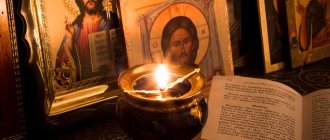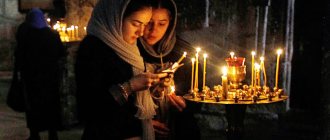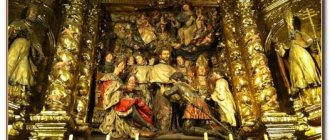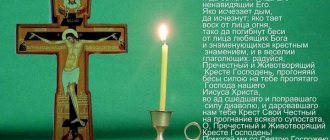APOSTOLIC SYMBOL OF FAITH
[Lat. Symbolum Apostolorum], the Symbol of Faith, along with the Niceno-Constantinople, adopted by the Roman Catholic Church. Proclaiming the significance for the comprehension of the “faith of all times” of the historically arose Creeds (Athanasiev, confessions of faith of certain Councils and popes), the Catholic. The Church distinguishes 2 of them, placing in 1st place the A.S.V., “so called because it is justifiably considered the correct presentation of the Apostolic Faith. This is the ancient baptismal Symbol of the Roman Church." At the same time, she recognizes the Nicene-Constantinople Creed as having “high authority due to the fact that it arose as a result of the first two Ecumenical Councils (325 and 381)” (CCC 194, 195).
The concept of Symbolum in the sense of confession of faith first appears in the middle. III century in the correspondence of St. Cyprian, bishop Carthage, and St. Firmilian of Caesarea, where the “Symbol of the Trinity” is mentioned, understood as an integral part of the continuation of the sacrament of St. Baptisms (Cypr. Carth. Ep. ad Magnum. 7-8; Ep. Firmiliani ad Cyprianum contra ep. Stephani. 10). But in general, in the first centuries of Christianity, the Symbol was designated in a different way (“rule of faith,” “teaching,” “tradition,” etc.). The name “Apostolic Symbol” is recorded in the message of the Milan Council (384) to Pope Sirius (Leclercq. Col. 1761), which states that this Symbol must always be unchangeably preserved by the Roman Church.
On Wednesday. centuries in the Roman Catholic Church there was a legend that on the day of Pentecost the apostles, being inspired by the action of the Holy Spirit, composed the Creed, so that each of them became the author of one of the 12 members of the Symbol. This legend dates back to the 4th century. (Ps.-Aug. Sermo 240. 1; Pirminius. De singulis libris canonicis scarapsus). It first appears in a sermon attributed to St. Ambrose of Milan (PL. 21. Col. 671), which states that the Symbol was compiled by 12 authors. At the same time, Rufinus of Aquileia (Comm. in Symb. Apost. 2) offers a detailed account of the composition of the Symbol, obtained, as he reports, from earlier times. Rufinus, while not explicitly attributing to each of the 12 Apostles the authorship of one member of the Symbol, nevertheless claims that the Symbol was the result of a joint work that took place at Pentecost (see also: Apostolic Decree VI 14). Moreover, as Rufinus believes, the apostles decided to call the rule of faith they compiled Greek. the word “symbol” (σύμβολον), which means, on the one hand, a sign by which Christians can recognize each other, and on the other, something unified, made up of various parts.
Based on historical research. theologians and historians have come to the conclusion that in modern times. form A.S.v. represents a baptismal confession of faith of the Roman Church, dating back to no earlier than the 2nd half. V century An older and shorter form of the Symbol existed in Rome already in the 2nd century. Baptismal catechesis took the form of questions (by the priest) and answers (by the catechumen). Until sep. II century in the Roman Church Greek. and lat. languages were in equal use. The exorcist or reader asked the catechumen in what language he would pronounce the confession of faith, and after that the members of the faith were read to the catechumens, perhaps they were read first in Greek, then in Latin. language for both Greek-speaking and Latin-speaking catechumens. Early Roman text. The baptismal symbol is contained in various versions in the “Explanatio symboli” of Nikita, bishop. Remesiansky, and Rufinus of Aquileia:
(1. I believe in God the Father Almighty; 2. and in Christ Jesus, His only begotten Son, our Lord, 3. born of the Holy Spirit and the Virgin Mary, 4. crucified under Pontius Pilate and buried, 5. rose from the dead on the third day , 6. ascended into heaven, 7. seated at the right hand of the Father, 8. from where He comes to judge the living and the dead, 9. and into the Holy Spirit, 10. into the Holy Church, 11. for the remission of sins, 12. for the resurrection of the flesh).
The genesis of the A.S. century, therefore, represents a consistent historical expansion of the baptismal trinitarian formula (Matt. 28.19; cf.: Didache. 7.2; 9.5), and in this sense it can be considered as having apostolic origin. K con. II century Ancient Rome. the baptismal symbol was known in Gaul and Africa - this can be judged from the works of St. Irenaeus of Lyons and Tertullian. Moreover, both Tertullian (De praescript. haer. 37) and St. Irenaeus (Adv. haer. I 10. 1, 2) insist that the “rule of faith” is part of the apostolic Tradition. Mn. “additions” that distinguish the “modern” text of A.S. century. from the ancient Roman symbol, were known to the blj. Jerome of Stridon († 419) and bishop. Nikita Remesiansky (5th century). Additions appear at the beginning. V century in Gaul. The final version of A.S.v. discovered in Rome ca. 700, but for a long time it coexists with the old Gallican confessions in various places (Leclercq. Col. 1771-1774).
Orthodox The Church, recognizing the Nicene-Constantinople Symbol as its confession of faith, reserves the ancient A.S. century. historical meaning.
M. Luther saw in all 3 Symbols - A. S. century, Athanasiev and Nicene-Constantinople - an expression of universal religious consciousness. Long before him, the 3 Symbols enjoyed authority in the Catholic Church. Churches and were used in worship. The Anglican Church in the Thirty-nine Articles recognizes A.S. century. compulsory.
E.P.B.
A.S.v. in zap. worship
In its entirety, it is included in the rites of the sacrament of Baptism of the following rites: Roman, Ambrosian, Gallican, Spanish-Mozarabic. In Celt. rite and in the liturgical tradition of the Churches of the Anglican Commonwealth (going back to the Celtic rite), the place of the baptismal Symbol is occupied by questions and answers, the order of which corresponds to the order of the A.S. century. In Lutheran. rite of Baptism A.S. pronounced in its entirety. From the rite of Baptism of A.S. moved to daily circle services: to Rome. and in the Spanish-Mozarabic rites it was read at the beginning of Matins (Matutinae), the 1st hour and (only in Romans) at the end of Compline; during the liturgical reform of the 2nd half. XX century (see Novus ordo) A.S.v. was excluded from the daily services of Rome. rite. A.S.v. found in the Celtic liturgical monument. ritual - the Bangor Antiphonary, but what place it occupied in the daily services is unclear; to the Anglicans. traditions of A.S.v. read at the end of morning and evening services.
In addition to the rites of the sacrament of Baptism and certain services of the daily circle of A.S. included in: in Rome. rite - the rite of ordination of a presbyter; in the Ambrosian rite - the rite of “surrender of the soul” (commendationis animae) of the dying person to God; in the Spanish-Mozarabic rite - Palm Sunday Masses (read before the apostolic reading); in Celtic rite - the preparatory part of the rite of the Sacrament of Anointing; to the Anglicans. traditions (in the form of questions and answers) - the order of visiting the sick (English: visitation of the sick; see Viaticum); among Lutherans - the Eucharistic rite (along with the Nicene-Constantinople Symbol). In modern Catholic Mass A.S. can be used instead of the Nicene-Constantinople Symbol (Volks-Schott).
Lit.: Kattenbuch F. Das apostolische Symbol: In 2 Bde. Lpz., 1894-1900; Meyer J. Luther und das Apostolikum // Zeit- und Streitfragen des Glaubens, der Weltanschauung und Bibelforschung. B., 1918. N 12; Cullmann O. Die ersten christlichen Glaubensbekentnisse. Zürich, 1943. (TSt; 15); Leclercq H. Symbole // DACL. 1951. Fasc. 170/171. Col. 1756-1778; Trillhaas W. Das apostolische Glaubensbekentnis: Geschichte, Texte, Auslegung. Gott., 1953; Volks-Schott: Taschenausgabe für die Sonn- und Feiertage. Freiburg i. Br., 1973. S. 262-267; Evangelisches Kirchengesangbuch. B., 1984. S. XVII; Marty F. Symbole // DSAMDH. 1989. T. 14. Col. 1364-1383; Ich glaube: Vierzehn Betrachtungen zum Apostolischen Glaubensbekentnis / Hrsg. v. W. Sandfuchs. Würzburg, 1975.
V. V. Chernov
APOSTOLIC SYMBOL OF FAITH - the earliest creed adopted by the Roman Church during the sacrament of baptism, the oldest of the three ecumenical (i.e. accepted by the entire Christian church) symbols or confessions of faith (Apostolic, Athanasian and Niceno-Constantinopolitan), the oldest summary of the foundations of Christianity creeds.
Its basis is undoubtedly very ancient: according to legend, it dates back to the time of the 12 apostles. According to Catholic tradition, it was compiled by the apostles on the day the Holy Spirit descended upon them, who briefly, each in one sentence, expressed the essence of the teachings about Christ, which then became one of the 12 members of the Apostles' Creed. Researchers suggest that it has a genetic link to baptismal confession. The modern form of the Apostles' Creed was written down by Caesar of Arles (6th century), but its origins are much older. Perhaps it was compiled back in the 2nd century. based on the catechism used for adult baptism. In its oldest form it reads: “I believe in God, the Father Almighty; and in Christ Jesus, His only begotten Son, our Lord, born of the Holy Spirit and the Virgin Mary, crucified under Pontius Pilate and buried, on the third day rose from the dead, ascended into heaven, sitting at the right hand of the Father, from whence He comes to judge the living dead; and into the Holy Spirit (without adding the Filioque), into the holy Church, into the remission of sins, into the resurrection of the flesh. Amen". At present, it is almost generally accepted that the initial Greek form of this symbol appeared even earlier than the middle of the 2nd century, but exactly when, opinions differ on this issue. In the Eastern Church, this symbol no longer has meaning and is completely supplanted and replaced by the Nicene-Constantinople (Nicene-Constantinople) Creed. It's a different matter in the West. Luther saw the expression of the universal church creed in three symbols and recognized the significance of the Apostles' Creed, although already 500 years before Luther the three symbols enjoyed high authority and were used in worship. The Apostles' Creed is currently used in the Catholic and Protestant churches. In the Church of England it is recognized as obligatory by 39 members and is used in various liturgical rites. Its liturgical use is also preserved in the Lutheran Church. In the Orthodox Church, which recognizes the Nicene-Constantinople symbol as the only formula of the confession of faith. The Apostolic Creed is not obligatory and accepted, but its antiquity and important theological significance are not denied. The problem of the origin of the Apostles' Creed is currently being resolved as follows. In its current form it arose no earlier than the end of the 5th century. and is an ancient formula for the confession of faith pronounced in the Roman Church during the sacrament of baptism. Its final consolidation in the liturgical rites (orders) and rituals of the Western Church occurs in the 9th century. and is associated with the liturgical reforms of Charlemagne. This is the southern Gallic form of a short Roman symbol used in the Roman Church in the 3rd, 4th and 5th centuries.
The importance of the Creed in Orthodoxy
Initially, the “Creed” prayer was intended for those who were preparing for the sacrament of baptism. She spoke in accessible language about the basic postulates and symbols of faith. That is, it explains what and how a person should believe.
At the dawn of Orthodoxy, people were baptized consciously as adults. Everyone, as before and now, goes to faith in their own way, known only to God. And this road to God is a great Sacrament. The “Symbol of Faith” shines as a guiding star for a person on the difficult spiritual path.
Nowadays, most people are baptized almost immediately after birth. The Creed is read for babies by their godparents. Without the sacrament of baptism it is impossible to follow Christ. The spiritual history of a person begins with baptism. He is born again and all other sacraments are revealed to him.








